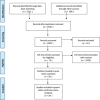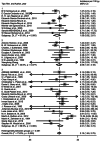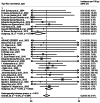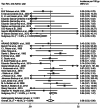Use of morselized bone allograft in revision hip arthroplasty for massive acetabular defect: A systematic review and meta-analysis
- PMID: 39634575
- PMCID: PMC11615971
- DOI: 10.1002/jeo2.70091
Use of morselized bone allograft in revision hip arthroplasty for massive acetabular defect: A systematic review and meta-analysis
Abstract
Purpose: Many treatment options are available for the revision of large acetabular defects. Debate continues as to which technique is most effective. This meta-analysis aimed to determine the rates of failure of acetabular bone defects Paprosky type III or American Academy of Orthopaedic types III-IV treated with morselized allograft in association with cemented cup or cementless cup or reinforcement devices.
Methods: The US National Library of Medicine (PubMed/MEDLINE), EMBASE and the Cochrane Database of Systematic Reviews were queried for publications from January 1980 to 1 April 2024 utilizing keywords pertinent to total hip arthroplasty (THA), acetabular impaction bone grafting and revision THA. The main outcome measure was the 9-year implant failure rate.
Results: Thirty-nine articles were eligible for inclusion in the current study. We found 41 treatment approaches that we grouped into three different treatment options: 1 = morselized allograft and cemented cup (10 studies); 2 =morselized allograft and cementless cup (nine studies); 3 = morselized allograft and device (22 studies). The overall implant failure rate was 2.1% (95% confidence interval [CI], 1.6%-2.8%) at a mean of 9.2 years. There was no significant difference in failure rates between different treatment options (1.6% [95% CI, 0.9%-2.6%]) for morselized allograft and cemented cup; 2.1% (95% CI, 1.4%-3.2%) for morselized allograft and cementless cup; 2.5% (95% CI, 1.7%-3.7%) for morselized allograft and device) between the three different types of treatment (heterogeneity between groups p = 0.351).It was determined that the number one cause of failure was aseptic loosening (80.5%), followed by infection (13.1%) and dislocation (6.4%). THA with reinforcement devices has a higher incidence of infection (3.6 vs. 0.7%, p = 0.001) and dislocation (1.4 vs. 0.6%, p = 0.010) than THA with a cemented cup.
Conclusions: The use of morselized allograft in hip revision of large acetabular defects has low implant failure rates, independently of the associated type of implant. Reinforcement devices increase the risk of re-revision for infection and dislocation.
Level of evidence: Level III.
Keywords: acetabular defect; hip; morselized allograft.
© 2024 The Author(s). Journal of Experimental Orthopaedics published by John Wiley & Sons Ltd on behalf of European Society of Sports Traumatology, Knee Surgery and Arthroscopy.
Conflict of interest statement
The authors declare no conflicts of interest.
Figures






Similar articles
-
Use of structural bone allograft in revision hip arthroplasty for massive acetabular defect: A systematic review and meta-analysis.J Exp Orthop. 2025 May 3;12(2):e70241. doi: 10.1002/jeo2.70241. eCollection 2025 Apr. J Exp Orthop. 2025. PMID: 40322511 Free PMC article. Review.
-
[Acetabular revision for aseptic loosening in total hip arthroplasty using cementless cup and impacted morselized allograft].Rev Chir Orthop Reparatrice Appar Mot. 2007 May;93(3):255-63. doi: 10.1016/s0035-1040(07)90247-0. Rev Chir Orthop Reparatrice Appar Mot. 2007. PMID: 17534208 French.
-
Cementing a Monoblock Dual-Mobility Implant into a Fully Porous Cup in Revision Total Hip Arthroplasty to Address Hip Instability: Surgical Technique.JBJS Essent Surg Tech. 2023 Nov 22;13(4):e22.00058. doi: 10.2106/JBJS.ST.22.00058. eCollection 2023 Oct-Dec. JBJS Essent Surg Tech. 2023. PMID: 38357466 Free PMC article.
-
Acetabular revision total hip arthroplasty using an impacted morselized allograft and a cementless cup: minimum 10-year follow-up.J Arthroplasty. 2011 Oct;26(7):1057-60. doi: 10.1016/j.arth.2011.03.035. Epub 2011 May 17. J Arthroplasty. 2011. PMID: 21592720
-
Acetabular Cup Revision Arthroplasty Using Morselized Impaction Allograft.Hip Pelvis. 2018 Jun;30(2):65-77. doi: 10.5371/hp.2018.30.2.65. Epub 2018 Jun 4. Hip Pelvis. 2018. PMID: 29896455 Free PMC article. Review.
Cited by
-
Finite Element Analysis of a 3D-Printed Acetabular Prosthesis for an Acetabular Defect According to the Paprosky Classification.Materials (Basel). 2025 Mar 15;18(6):1295. doi: 10.3390/ma18061295. Materials (Basel). 2025. PMID: 40141579 Free PMC article.
References
-
- Buckup, J. , Salinas, E.A. , Valle, A.G.D. & Boettner, F. (2013) Treatment of large acetabular defects: a surgical technique utilizing impaction grafting into a metallic mesh. HSS Journal®: The Musculoskeletal Journal of Hospital for Special Surgery, 9(3), 242–246. Available from: 10.1007/s11420-013-9350-z - DOI - PMC - PubMed
Publication types
LinkOut - more resources
Full Text Sources
Research Materials
Miscellaneous

